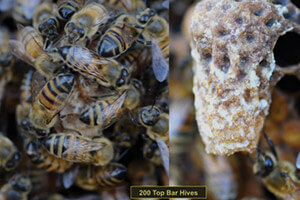
In this article, we study finding queen cells in difficult situations. Three circumstances cause bees to rear queens: swarming to replace the mother queen who leaves with the prime swarm, supersedure to replace the mother queen who may be failing, and sudden loss of a mother queen.
Beekeepers need to be skilled at finding queen cells in these circumstances. It seems a simple matter to find the peanut-shaped queen cells protruding from the combs. True. If all queen cells were built like that. And if there were no bees in the hive covering them up. The peanut-shaped search image is useful, but a knowledgeable beekeeper does not rely on it completely. In most cases, the bees are very attentive to queen cells and literally coat queen cells with bees constantly walking over them. So I look for knobs of bees on the comb, not produced by burr comb underneath.
Figure 1, left side, shows a close up of a bulge of bees on the face of the comb. The timing was in the Spring, swarm season, and from 50 years of beekeeping, I was hunting queen cells by merely looking at a brood comb. Nudging the bees away gently with a fingertip revealed a queen cell with an older larva. Notice the base of the queen cell is gray, made of older wax, most likely a queen cell cup. Also see how the base of the queen cell is completely out of the adjacent cells, and the side of the queen cell attaches to the comb. Both constructions indicate the queen cell originated from a queen cell cup, common with queen cells built for swarming and supersedure. In this situation, the advice is that a few queen cells located more centrally on the comb indicate queen supersedure.
From a bee management perspective (not willing to risk a swarm lost), any queen cells in the Spring give the colony the opportunity to swarm, even if the colony began only to supersede its queen. In a summer dearth, a few queen cells could still result in queen supersedure. Now, however, matters are more complicated in the Summer. The queen cells allow the option for the production of a usurpation swarm. So now I am always looking for any bulge of bees on the comb, Spring and Summer.
Figure 2 (left side) shows a bulge of bees on the edge of the comb. In a crowded hive, the contour of the bulge may become obscure in the thick bee coverage. On the right side of Figure 2, I removed the bees to reveal a queen cell, which the bees have capped.
For cryptic queen cells, the difficult ones to find, I confirm their presence with two more characteristics, because the typical queen-cell shape is not dependable in these situations. First are the little pits on the sides of a queen cell. These pits are consistently smaller than the irregular cells in burr comb. The queen cell in Figure 2 (right side) has these pits. Examining a comb, I may only glimpse a tiny patch of pits with the bees scampering by, but it says here is the side of a queen cell. Occasionally, queen cells can be built with smooth sides, eliminating the pits as a search aid. I find queen cells built during emergency queen loss can result in smooth-sided cells, particularly if foraging conditions are poor.
However, another queen-cell characteristic, perhaps the most important one, becomes vital in …


